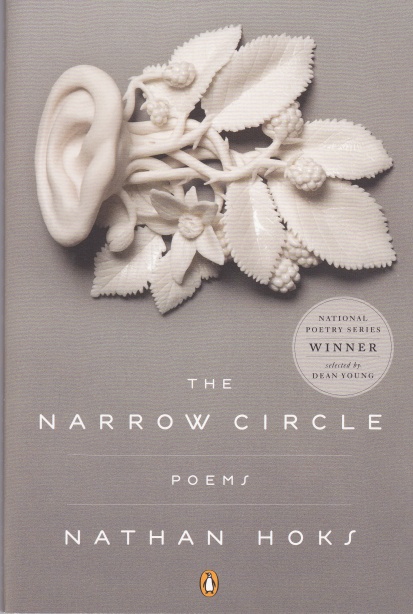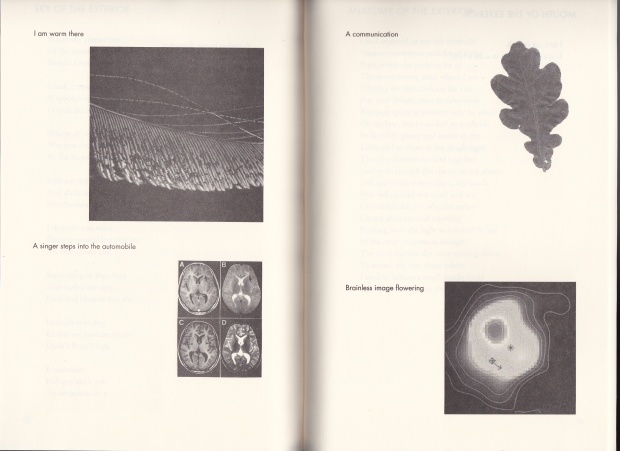The Narrow Circle of Nathan Hoks
When I open my mouth, a whale swims out and I am the hologram projected from its spout.
Duality provides the structure for Nathan Hok’s book of poems The Narrow Circle. The forty-four poems are divided equally into two sections called The Interior and The Exterior, but the poems themselves seem to be doing everything they can to eradicate the boundary between inner and outer. The book’s telling epigram comes from William Blake:
They told me that I had five senses to inclose me up.
And they inclos’d my infinite brain into a narrow circle,
And sunk my heart into the Abyss, a red round globe hot burning
Till all from life I was obliterated and erased.
Not surprisingly, the fives senses are on high alert throughout Hok’s poems, but especially the ear and the mouth as primary instruments of communication. There are multiple references to the mouth, which uniquely among the senses serves as a two-way passageway between inner and outer. The mouth receives sustenance, the mouth emits language.
“Mouth eats poem. Falls from rafters.” (from Mouth of the Interior.)
“Film comes/Whirring out of his mouth.” (from People of the Interior)
“When the sky comes out/Of the mouth/Should I break it -” (from Sky of the Exterior)
“I feel my mouth./It is a child crying in a dark bed.” (Mouth of the Interior, complete poem)
And here is the complete poem Edge of the Exterior:
My mouth has become
The edge of me.It spills outward
Like a spool of threadWhich I can use to stitch up
The rest of my face.I am so afraid
Of this mouthI keep it as far
From me as possible.Here it is –
I hold it towards you.
After every five or six poems there is a double page spread on which we see four brief texts that have been extracted from the previous set of poems. These texts can be single words, brief phrases or a full line from one of the poems, and here each text is associated with a photograph. (There are a total of eight of these photo spreads.) These text/image spreads seem to act as a sort of refrain that reinforces the idea that all of the poems share some common goals or themes. But these refrains also act like new poems unto themselves, poems that force us to deal with the inner/outer issue head on. (I should probably be just a bit cautious about calling these double page spreads “poems,” since they do not have titles and their existence is not acknowledged in the Table of Contents.) In these text/image “poems”or spreads we undertake the normal activity called upon by a book, we read words – an “inner” activity of the brain in which we convert language into images. But we are simultaneously asked to read images – a process by which we pull the outer world inside to be digested, and we are challenged to find common ground between the two forms of “writing”: text-writing and image-writing. In some instances the text and the image essentially say the same thing, while at other times we must puzzle over the relationship between the text and the image. The images themselves show us things from the exterior world and (unseen) glimpses into the inner world, such as X-rays, images of sub-atomic particles, and brain scans.
Hoks seems to be trying to find a way to avoid being “inclos’d” by his senses, but instead to use them to erase barriers between the inner life and the exterior life, between dreamed/imagined events and observed events, between emotions and the objects and events that cause them. We see this clearly in the line quoted at the beginning of this post: “When I open my mouth, a whale swims out and I am the hologram projected from its spout” (from Letter of the Exterior). Reversing the Biblical story of Jonah, here the poet disgorges a whale, projecting his own imagination upon the world, but the holographic image of the poet is real enough to turn back and examine the poet.
Here’s the last third of the final poem in the book, Mind of the Exterior:
What is the body?
The body becomes light.Where is it going?
To the other side of the couch.When will it get there?
When morning comes around again.Why is it a circle?
I am a circle.What is a circle?
A way to be erased.
The hand-built porcelain work of art on the cover, Kate MacDowell‘s Taking Root, 2009, is a brilliant evocation of Hok’s book.
Nathan Hoks. The Narrow Circle. NY: Penguin, 2013.


